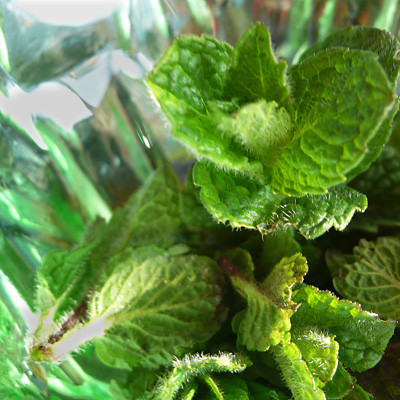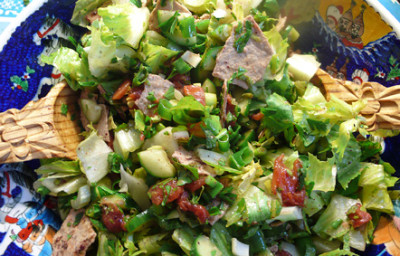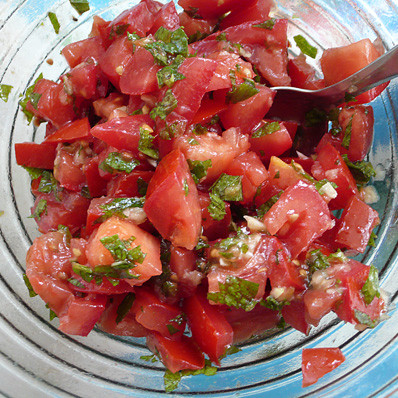How to Use Spearmint: An Aromatic, Medicinal Herb
Thursday, April 23, 2015
"As for the garden of mint, the very smell of it alone recovers and refreshes our spirits, as the taste stirs up our appetite for meat."—Pliny the Elder
Whether you are vegan or carnivorous, aromatic spearmint adds fresh, nourishing flavor and brightness to innumerable foods, while filling your kitchen with its fragrance by its mere presence. Beyond being a throw-away garnish, a color accent, or a minor player, spearmint can be a star in the kitchen.
See Slides Below: Cooking With Spearmint and Other Greens
Native to the Mediterranean, mint leaves have long been utilized in medicinal and culinary ways. In Spanish, spearmint is called yerba buena, meaning the good herb, a nod to its overall usefulness and nobility. On a visit to Guanajuato, Mexico, a vegetarian burger I ordered in a little cafe pleasantly surprised me with spearmint mellowing out the fresh minced jalapeño peppers. Those are the only ingredients I remember and inspire my homemade vegan burgers.
GET THE LATEST BREAKING NEWS HERE -- SIGN UP FOR GOLOCAL FREE DAILY EBLASTWhen mint is mentioned in culinary speak—unless specified otherwise like peppermint—spearmint is the herb called for. Simple to grow—in fact difficult to hold back—it is best planted near the kitchen in the a contained bed rather than a pot, for easy snipping. Another advantage to growing it easily from a slip, if you live out of the urban center, it's immune to our hungry suburban deer population who abhor aromatics. So it's safe to plant along with rosemary, lavender, and other fragrant herbs. My Moroccan mint (a varietal sister to spearmint) is almost two feet high—time to harvest and dry for tea and winter salads. Cutting it back prevents it from flowering and seeding, allowing it to produce fresh mint leaves throughout the summer and fall.
For me, the aroma of spearmint stirs my appetite for salads! Notorious Middle Eastern salads created with mint as a star include our basic salad dressed with lemon, garlic, and olive oil, tabbouli, fattoush, yogurt and cucumber salad, my father's tomato and garlic salad, and the Lebanese cabbage and coleslaw featured in my Italian parsley article two weeks ago. It is part of the filling in stuffed chard rolls, summer grape leaves, Lebanese summer squash, and in vegan spinach pies. My favorite falafel sandwich in Beirut was packed with fresh spearmint and Italian parsley, along with tomatoes, liffit (pickled turnips), and tahini sauce. The fantastic yalangi (a Turkish word for vegetarian grape leaves) I tasted in Beirut were made of eggplants whose filling included spearmint, and served cold at restaurant Ta Marbouta in Hamra.
In Arabic, the word for spearmint is na'na'. Lebanese omelets, ijhee, are made with Italian parsley, mint, and green onions—a noble culinary trio. A reference to spearmint in a research paper I found was written 10 years ago about Lebanese in New England with a quote framing the essential relationship of na'na with the Lebanese by a Lebanese couple who were house hunting: "…that was when I first noticed the mint growing everywhere. It was running through the flowerbeds and even through the cracks in the foundation of the house, through the concrete! We knew immediately this must have been a Lebanese house at some point. Who else would have large plots of mint around here? We laughed at the hearty nature of the herb—it is so resilient! It will keep on growing despite having no Lebanese owners tending it." These words are a cautionary note to planting it! Yet, It is easy to pull up and you can give the rooted starts to your friends, even if they're not Lebanese!
My old friend, Gus Haddad, who opened Portland's Al-Amir restaurant in the 1980s and is from my family village of Douma, Lebanon, served the best baba ghannouj, seasoned with the secret addition of dried mint. I adapted my mother's baba ghannouj recipe in Alice's Kitchen adding just a bit of dried mint. It is superb.
Other typical Eastern Mediterranean uses are in sweet tea, such as Moroccan mint tea; my summer favorite Lebanese beverage is fresh squeezed, homemade lemonade with a sprig of fresh mint truly adding an unmistakably refreshing flavor and festive (think nonalcoholic mojito).
Mojitos, mint julep (from the Arabic beverage jallab), and creme de menthe are alcoholic mint beverages that can be digestifs, made with spearmint. With summer approaching, I will try my hand at mojitos!
Bring on the menthe spicata for vegans and carnivores alike! Plant it in your kitchen garden and use it in your kitchen now!
—Linda Dalal Sawaya is an artist, cook, Master Gardener, and author of Alice's Kitchen: Traditional Lebanese Cooking.
Remember, as my mother Alice said, "If you make it with love, it will be delicious!"
Related Slideshow: Cooking With Spearmint and Other Greens
All photos by © linda dalal sawaya
Related Articles
- Fresh Local Food for Thanksgiving in RI
- B&G Foods Issues Allergy Alert, Recalls Taco Products
- Report: 1 in 7 RI Households Can’t Afford Food
- RI Health Department Releases 10 Food Safety Tips for the Holidays
- Narragansett Council Boy Scouts Has Collected 8 Million Pounds of Food in 27 Years
- DownCity Named One of 10 Hot Food Neighborhoods in US
- Kraft Foods Recalls Kraft American Singles Pasteurized Prepared Cheese Product
- Rhode Island Community Food Bank Competes for $60,000 Grant
- Rhode Island’s Best Comfort Food
- Boy Scouts Announce “Scouting for Food” Drive in RI
- Johnny Cakes, RI’s Comfort Food












